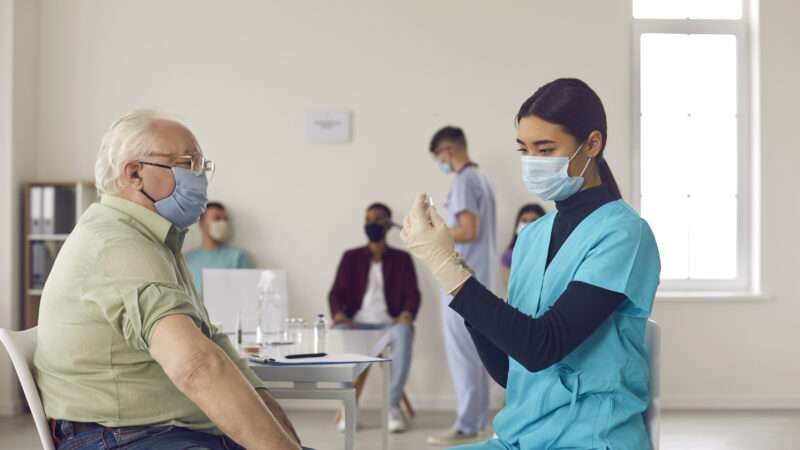A new report on Elijah McClain’s fatal 2019 encounter with police in Aurora, Colorado, concludes that the 23-year-old black man’s death followed a series of unconstitutional decisions, the questionable use of force, and reckless medical care by EMTs who injected him with an outsized dose of ketamine. In the 157-page report, an independent panel appointed by the Aurora City Council also criticizes the police department’s slipshod investigation of the incident, which provoked local protests and became yet another exhibit in the national conversation about police brutality and racially biased law enforcement.
On a Saturday night in August 2019, McClain had just bought a bottle of iced tea at a local convenience store and was walking home when he was accosted by Officer Nathan Woodyard. The officer was responding to a 911 call from a teenager who thought McClain “look[ed] sketchy” because he was wearing a ski mask and making “all these kinds of signs” with his hands. The caller added that “he might be a good person or a bad person.” He said no one was in danger and he had not seen any weapons.
Woodyard ordered McClain to stop, but McClain, who was listening to music through earbuds and apparently did not hear the command, continued walking. He was holding his cellphone in one hand and the bag with his purchase in the other. “Within ten seconds of exiting his patrol car,” the report notes, “Officer Woodyard placed his hands on Mr. McClain. Mr. McClain had no observable weapon and had not displayed violent or threatening behavior. No crime had been reported. The officers later said they stopped Mr. McClain because he was overdressed and wearing a mask, in an area one officer referred to as ‘high crime,’ and a caller had reported his unusual behavior.”
In addition to an open-faced ski mask, McClain was wearing sweat pants and a long-sleeved shirt, which might have seemed strange on an August night but is understandable in light of his anemia, a symptom of which is cold extremities. Aside from his clothing and the “unusual behavior” reported by the 911 caller, Woodyard had no reason to suspect that McClain was doing anything illegal.
The Supreme Court has said the Fourth Amendment requires “reasonable suspicion of criminal activity” to justify an investigatory stop. “Officer Woodyard’s decision to turn what may have been a consensual encounter with Mr. McClain into an investigatory stop—in fewer than ten seconds—did not appear to be supported by any officer’s reasonable suspicion that Mr. McClain was engaged in criminal activity,” the panel’s report says. “This decision had ramifications for the rest of the encounter.”
Woodyard, who was “joined immediately by Officers Jason Rosenblatt and Randy Roedema,” then decided to frisk McClain, a step that is legally justified only if police reasonably suspect the subject is armed. Yet the 911 caller had not reported any weapons (a point that was noted in the police dispatcher’s message), McClain was plainly holding nothing but his phone and the bag from the convenience store, and Woodyard himself later said he “felt safe making an approach” because McClain “didn’t have any weapons.” The panel’s report says “we were not able to identify sufficient evidence that Mr. McClain was armed and dangerous in order to justify a pat-down search.”
McClain, whose walk home had been forcibly interrupted for no good reason, was understandably dismayed. He repeatedly asked the cops to leave him alone and let him continue on his way. “I have a right to walk to where I’m going,” he told Woodyard. “I have a right to stop you because you’re being suspicious,” Woodyard replied as he grabbed McClain’s arm.
The encounter escalated quickly. “Less than one minute from when Officer Woodyard first exited his vehicle and commanded Mr. McClain to ‘stop,'” the report notes, “the officers decided to physically move him to a grassy area nearby in case they needed to take him to the ground. Officers Rosenblatt and Woodyard, who were each holding one of Mr. McClain’s arms, attempted to move him several steps onto the grass, and Officer Rosenblatt stated ‘we’re going to lay you down, okay, come on.’ This decision likewise cannot be justified by the record available to the Panel.”
At this point, Woodyard’s unjustified investigatory stop became an arrest, which is constitutionally permissible only when police have probable cause to believe someone has committed a crime. That is a higher standard than reasonable suspicion, a test the cops had already failed to meet. “Since Officer Woodyard’s order to him to stop, the only facts that had changed were Mr. McClain’s attempt and stated intention to keep walking in the direction he had been going and his ‘tensing up,'” the report says. “In the Panel’s view, none of these facts would be sufficient to establish probable cause of a crime.”
While the cops were trying, without any legal justification, to force McClain onto the grassy area, Roedema exclaimed, “He grabbed your gun, dude.” That statement, Woodyard later said, “changed the situation.” While tackling McClain, the officers twice attempted a “carotid control hold,” which involves applying pressure on both sides of the neck to cut off blood flow to the brain and induce unconsciousness. The second, more successful attempt happened after McClain was restrained on the ground.
“Once he was lying on the ground, Mr. McClain’s ability to reach an officer’s gun or other weapons was limited by the fact that Officer Woodyard was on the ground behind him, with his gun and pepper spray pinned beneath him,” the report says. “If Mr. McClain was no longer presenting a threat of harm to the officers, there would have been no justification for Officer Woodyard to apply a carotid hold.” The body camera footage is unclear at this point, because the cameras were dislodged during the struggle. But the available record “does not provide evidence of the officers’ perception of a threat that would justify Officer Woodyard’s carotid hold, which caused Mr. McClain to either partially or fully lose consciousness.”
The officers described McClain as violently resisting them, justifying the use of “pain compliance” techniques even after he was handcuffed. But the audio record and the limited video tell a different story. McClain, who was five feet, seven inches tall and weighed 140 pounds, was “surrounded by officers, all larger than he, crying out in pain, apologizing, explaining himself, and pleading with the officers.” The audio “records Mr. McClain crying out in pain, apologizing, vomiting, and at times sounding incoherent. His words were apologetic and confused, not angry or threatening. He became increasingly plaintive and desperate as he struggled to breathe.”
Based on the available evidence, the report says, it is unclear “whether Mr. McClain’s movements, interpreted by the officers as resisting, were attempts to escape or simply an effort, voluntary or involuntary, to avoid the painful force being applied on him, to improve his breathing, or to accommodate his vomiting.” It notes that “the responding officers applied pain compliance techniques and restraints to Mr. McClain continuously from the first moments of the encounter until he was taken away on a gurney.”
Paramedics from Aurora Fire Rescue arrived about 10:53 p.m., 11 minutes after Woodyard first approached McClain, but they waited several minutes before attending to him. Rather than check his vital signs or render aid, they “decided to sedate Mr. McClain without conducting anything more than brief visual observation.” Aurora Fire Lt. Peter Cichuniec advised EMTs to inject McClain with a 500-milligram dose of ketamine, based on the officers’ impression that he was experiencing “excited delerium.” Cichuniec prescribed that dose “based on a grossly inaccurate and inflated estimate of Mr. McClain’s size.” He estimated that McClain weighed 190 pounds, 50 pounds more than his actual weight.
At the time of the injection, McClain “had not moved or made any sounds for about one minute.” Yet Cichuniec “determined it was appropriate to administer ketamine to Mr. McClain despite the fact that he did not appear to be offering meaningful resistance.” McClain’s heart stopped around 11:04 p.m., shortly after the injection. Although he was eventually resuscitated, he was declared brain dead at a hospital three days later. “The events leading to the medical crisis that resulted in Mr. McClain’s death occurred rapidly, within an eighteen-minute period,” the report says. “The autopsy concluded that Mr. McClain died of undetermined causes.”
According to the report, the investigation of the incident by the Aurora Police Department’s Major Crime/Homicide Unit “raised serious concerns” and “revealed significant weaknesses in the Department’s accountability systems.” During their interviews, detectives “failed to ask basic, critical questions about the justification for the use of force necessary for any prosecutor to make a determination about whether the use of force was legally justified.” The questions “frequently appeared designed to elicit specific exonerating ‘magic language’ found in court rulings.” The investigators’ report, on which both the district attorney and the police department’s Force Review Board relied, “failed to present a neutral, objective version of the facts and seemingly ignored contrary evidence.”
Unsurprisingly, the Force Review Board’s examination of the incident was “cursory and summary at best.” The case “was never referred to Internal Affairs investigators,” which would have required the police chief’s approval. That policy, the panel’s report says, “places the Chief in a difficult and potentially compromised role, and limits the independence of Internal Affairs to investigate potential failures to comply with Department policy.”
The panel recommends several steps to “lessen the chance of another tragedy like this one.” They include better training and supervision, a review of the department’s policies regarding de-escalation and the use of force, improved cooperation between police and emergency medical personnel, a reexamination of sedation practices, and “an overhaul of the post-incident review process.”
This report reveals that Aurora police officers either do not understand the constitutional constraints on their behavior or cannot be bothered to comply with them. That goes for the remarkably incurious detectives who investigated the incident as well as the officers who illegally detained and assaulted McClain.
This blithe disregard for constitutional rights, which in this case had lethal consequences, reinforces the indictment laid out in the state lawsuit filed last month by Brittney Gilliam. Like McClain, Gilliam was detained by Aurora cops even though she had done nothing wrong. With guns drawn, they forced her to lie on the pavement along with her 6-year-old daughter, 17-year-old sister, and two teenaged nieces, all because of a stupid error that could have been easily rectified if only the officers had been paying attention: They mistook her SUV with Colorado plates for a stolen motorcycle registered in Montana.
“This was a horrible mistake,” Aurora Police Chief Vanessa Wilson acknowledged in January. But Gilliam’s lawsuit describes dozens of similar “mistakes” by Wilson’s officers, including unconstitutional searches, illegal detention, trumped-up arrests, and excessive force.
Aurora cops “have a history of committing police brutality, especially against Black victims, and racially profiling Black individuals,” the complaint says. From 2013 through 2019, it notes, the Aurora Police Department “ranked 8th out of the 100 largest cities in the United States for most police killings per capita.” The lawsuit also cites statistics indicating that black people are disproportionately likely to be mistreated by Aurora police.
That track record suggests the department’s policies and practices invite such abuse. The Justice Department’s investigation of McClain’s death may shed further light on the issue.

from Latest – Reason.com https://ift.tt/3pKUbq1
via IFTTT



